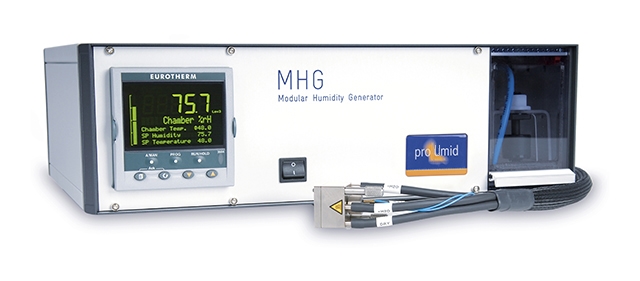What is a Humidity Generator ?

The term “Humidity Generator” is used for a wide range of devices for obtaining such a controlled humidity, which makes it difficult to give a precise definition, and equally difficult to choose a suitable system.
Applications of Humidity Generators
There are many reasons for wanting to adjust humidity in a chamber or volume.
- Calibration of humidity sensors
- Adjustment of measurement conditions for humidity sensitive samples
- For processing of materials, foods, pharmaceuticals, and many other powders.
- Conditioning and storage of products, raw materials, and intermediates.
- In conservation of artworks, archaeological artefacts, and other objects.
Typical components of a humidity generator
Most humidity generators have at least the following parts :
- The Target system is the chamber or volume where we want to regulate the humidity.
- A humidity sensor measures the relative humidity or dewpoint of the gas.
- A humidity source gives a means of adjusting the humidity inside the target system.
However, even on this simple basis, there are many different configurations, and many considerations which must be taken in to account.
Is the target system internal to the humidity generator ?
External target chamber
The MHG-32 pictured above is designed for an external target chamber. The supply head of the MHG-32 gives a stream of humidified air, to regulate the humidity inside an external system. The humidity sensor can be installed inside the target chamber at the point of use. This modular design allows the MHG-32 to adjust to the temperature, volume, and flow requirements of the external system.
Internal target chamber
Many advertised Humidity generator units are in reality constant humidity chambers - and therefore have an internal target chamber.
- When designed to accept one or more RH sensors for verification or calibration, these are often called “Humidity calibrators”
- Others are used for storage of objects or materials at constant RH and temperature - “Humidity chambers”.
- In many cases, the internal chamber is designed to operate under isothermal conditions, although the temperature may be adjustable.
Two temperature and two pressure humidity calibrators
These methods generate a flow of humidity saturated gas at a lower temperature, or at a higher pressure, than the target chamber. When the temperature or pressure are changed to the target value, a new Relative Humidity value is obtained. These are often used for calibration purposes, because they allow the use of very tracable pressure and temperature sensors to give a precise calculation of the humidity in the target chamber. A humidity sensor is only necessary for verification, or as a convenience. However, they are often only qualified for use in a limited range of flows, and are often not suitable for rapid changes of humidity.
Continous flow vs static or semi-static systems
- Using a continuous flow of humidified air allows rapid and precise changes of humidity, with minimal perturbation of temperature, even when the humidity is rapidly absorbed inside the target system.
- Intermittent or zero flow systems give lower consumption of energy and water, but can allow accumulation of impurities released inside the target system.
Position of humidity measurement
Simple isothermal target chamber
For systems with internal target chamber, the RH sensor measures humidity inside the target chamber, with direct feedback to the humidity source.
For continuous flow systems with external target chamber, this is also the simplest configuration, with the RH sensor at the point of use inside the target chamber.
Multi-zone configurations
In many applications it is not possible to introduce the humidity sensor at the point of use. For example :
- High or low target temperatures
- Chemical contamination, electrical interference, radiation, x-rays, at the target position.
- Lack of physical space inside the target zone.
For these cases, it is useful to separate the system into three or more zones:
- the humidity source
- a combined humidity and temperature measurement
- the point of use, which may be at a different temperature and physically separated from the other parts
- transfer tubes or ducts, where the flow of gas is transferred between the other zones, while avoiding condensation.
With careful attention to the design of the external target chamber, a modular humidity generator such as the MHG-32 can give precise regulation of humidity, while adjusting to changes of temperature of the target chamber.
Unusual methods of Humidity Generation
Saturated salt solutions
For small closed volumes, it is possible to use deliquescent salts in saturated solution to give a constant relative humidity, provided that the temperature remains constant. Normally, it is necessary to ensure that the saturated salt solution is in direct contact with un-dissolved salt.
Unsaturated electrolyte solutions
Unsaturated solutions can also be used for humidity control in small closed volumes. Typical solutions are Sulphuric acid, Potassium Hydroxide, Calcium Chloride. Compared with saturated solutions, it is even more important to ensure that the solution is uniformly mixed and that the system is completely air-tight, because there is no buffering effect from free undissolved solid solute. Although the concentration can be adjusted to obtain any desired humidity value, this method is rarely used.